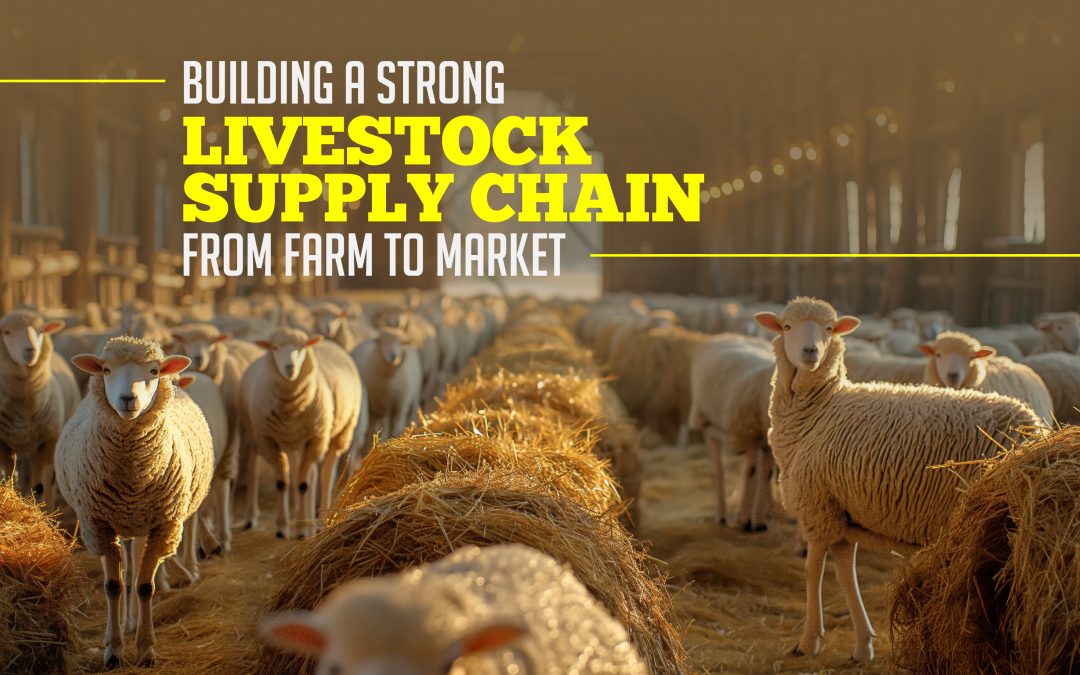In the livestock industry, a strong supply chain is crucial for ensuring that products move efficiently from the farm to the market. A well-managed supply chain enhances profitability, ensures quality, reduces waste, and meets consumer demand for fresh, ethically produced products. In this blog, we’ll explore the key components of a robust livestock supply chain, discuss common challenges, and offer strategies to optimize each stage of the process. Additionally, we’ll delve into the importance of selecting the right livestock breeds, ethical farming practices, and effective marketing strategies to reach the right buyers.
Understanding the Livestock Supply Chain
The livestock supply chain encompasses all the processes involved in raising, processing, and delivering livestock products, such as meat, dairy, and wool, to consumers. It begins at the farm and ends when the product reaches the market. The primary stages include:
- Farm Production
- This is where the livestock is bred, raised, and managed. Key considerations at this stage include selecting the right breeds, maintaining animal health, and optimizing feed and nutrition.
- Transportation
- Once livestock or livestock products are ready for market, they must be transported. This stage involves moving live animals or processed products from farms to processing facilities, and eventually to distribution centers or retailers.
- Processing
- Processing may involve slaughtering, butchering, packaging, or other forms of product transformation. Maintaining high standards of hygiene and efficiency is critical during this stage to ensure product quality and safety.
- Distribution
- After processing, products are distributed to retailers, wholesalers, or directly to consumers. Efficient logistics and cold chain management are vital to preserving product freshness and quality during transit.
- Retail and Market
- The final stage is selling the livestock products to consumers. This could be through supermarkets, local markets, restaurants, or online platforms. Ensuring that products are displayed attractively and marketed effectively is key to driving sales.
How to Choose the Right Livestock Breeds for Your Farm
Selecting the right livestock breeds is fundamental to the success of your farm. The breed you choose will impact everything from productivity to marketability. Here’s how to make the right choice:
- Assess Your Farm’s Environment
- Different breeds thrive in different climates and environments. For example, some cattle breeds are better suited to hot climates, while others perform well in cooler regions. Consider your farm’s climate, soil quality, and available resources when choosing a breed.
- Understand Market Demand
- Research the local and regional demand for different livestock products. Certain breeds may produce meat, milk, or wool that is more in demand in your area. Choose breeds that align with consumer preferences and market trends.
- Consider Feed and Maintenance Requirements
- Some breeds require specific types of feed or have higher maintenance needs. Calculate the costs and logistics involved in meeting these requirements. Breeds that are more self-sufficient or have lower maintenance needs may be more cost-effective in the long run.
- Focus on Breeding Potential
- If you plan to expand your livestock population, consider the breed’s reproductive efficiency. Some breeds have higher fertility rates, shorter gestation periods, and greater offspring survival rates.
- Evaluate Health and Disease Resistance
- Breeds with strong resistance to common diseases and health issues will reduce veterinary costs and improve overall herd health. Research the breed’s susceptibility to diseases common in your area.
Ethical Livestock Farming: Meeting Consumer Demand for Humane Practices
In today’s market, consumers are increasingly concerned with the ethical treatment of animals. Ethical livestock farming not only meets consumer demand but also contributes to better product quality and sustainability. Here’s how to implement humane practices on your farm:
- Provide Adequate Space and Living Conditions
- Ensure that your livestock has enough space to move freely, socialize, and exhibit natural behaviors. Overcrowding can lead to stress, disease, and poor product quality.
- Implement Stress-Reduction Techniques
- Handling and transportation can be stressful for animals. Use gentle handling techniques, reduce noise, and provide comfortable transportation conditions to minimize stress.
- Adopt Humane Slaughter Practices
- If your livestock is raised for meat, follow humane slaughter practices that minimize pain and distress. This not only aligns with ethical standards but can also result in better meat quality.
- Seek Certification
- Obtain certifications such as Animal Welfare Approved (AWA) or Certified Humane® to build consumer trust and differentiate your products in the market. These certifications can also command premium prices.
- Educate Consumers
- Transparency is key. Provide information on your ethical farming practices through labeling, marketing materials, and your website. Educated consumers are more likely to support farms that prioritize animal welfare.
Marketing Strategies for Your Livestock Business: How to Reach the Right Buyers
Once you have a strong supply chain and ethical practices in place, it’s time to focus on marketing your livestock products. Here are some strategies to help you reach the right buyers:
- Define Your Target Market
- Identify who your primary customers are—whether they’re local butchers, supermarkets, restaurants, or individual consumers. Tailor your marketing efforts to meet the needs and preferences of these buyers.
- Leverage Online Platforms
- Create an online presence through a website, social media, and e-commerce platforms. Highlight your farm’s unique selling points, such as ethical practices, breed quality, and sustainability.
- Build Relationships with Retailers and Wholesalers
- Establish strong relationships with retailers and wholesalers who can distribute your products. Provide them with consistent quality and reliable supply to build long-term partnerships.
- Participate in Farmers’ Markets and Trade Shows
- Farmers’ markets and trade shows are excellent venues to showcase your products, engage with potential customers, and receive direct feedback. These events also allow you to build your brand locally.
- Utilize Content Marketing
- Share stories, blogs, and videos about your farm, animals, and practices. Content marketing helps build trust and educates your audience about the benefits of your products. Highlighting behind-the-scenes aspects of your operation can create a strong connection with consumers.
- Offer Value-Added Products
- Consider creating value-added products, such as organic meat, specialty cuts, or artisanal cheeses, to attract niche markets. Value-added products often command higher prices and can set your brand apart.
Challenges in the Livestock Supply Chain
Building a strong livestock supply chain involves overcoming several challenges:
- Animal Welfare Concerns
- Ensuring the humane treatment of animals during transport and processing is not only ethically important but also affects product quality. Stress and poor handling can lead to lower meat quality and increased disease risk.
- Logistics and Transportation
- Livestock transport requires specialized vehicles and handling to prevent stress and injury. Additionally, processed products need reliable cold chain logistics to maintain freshness.
- Regulatory Compliance
- Livestock supply chains must adhere to numerous regulations related to animal welfare, food safety, environmental impact, and labor practices. Staying compliant requires constant monitoring and updating of practices.
- Market Fluctuations
- Changes in consumer demand, economic conditions, and global trade policies can impact prices and demand for livestock products. Farmers and suppliers need to be agile and responsive to these fluctuations.
- Supply Chain Transparency
- Consumers are increasingly demanding transparency in how their food is produced. Providing clear information about the sourcing, processing, and ethical practices involved can build trust and brand loyalty.
Strategies for Strengthening Your Livestock Supply Chain
To overcome these challenges and build a resilient livestock supply chain, consider the following strategies:
- Invest in Technology
- Technology can play a significant role in streamlining supply chain operations. For example, IoT devices can monitor livestock health and location during transport, while blockchain technology can enhance traceability and transparency.
- Enhance Animal Welfare Practices
- Implement best practices for handling and transporting livestock to minimize stress and injury. Providing adequate space, ventilation, and hydration during transport can improve animal welfare and product quality.
- Optimize Logistics and Cold Chain Management
- Invest in reliable transportation and storage solutions to ensure that livestock products remain fresh and safe from farm to market. Consider working with logistics partners who specialize in handling perishable goods.
- Build Strong Partnerships
- Collaborate with trusted suppliers, processors, and distributors to ensure consistency and quality across the supply chain. Building long-term relationships can lead to better communication and coordination.
- Adapt to Market Changes
- Stay informed about market trends and consumer preferences to adjust production and distribution strategies accordingly. Flexibility in your supply chain can help you quickly respond to changes in demand or supply disruptions.
- Focus on Sustainability
- Incorporate sustainable practices at every stage of the supply chain, from reducing waste and emissions to sourcing feed and materials responsibly. Sustainability not only benefits the environment but can also appeal to eco-conscious consumers.
Conclusion
Building a strong livestock supply chain requires careful attention to every stage, from farm production to market delivery. By choosing the right livestock breeds, adhering to ethical farming practices, and implementing effective marketing strategies, you can create a resilient and profitable livestock business. As consumer preferences evolve and market conditions change, staying agile and responsive will help you maintain a competitive edge and ensure long-term success in the livestock industry.













